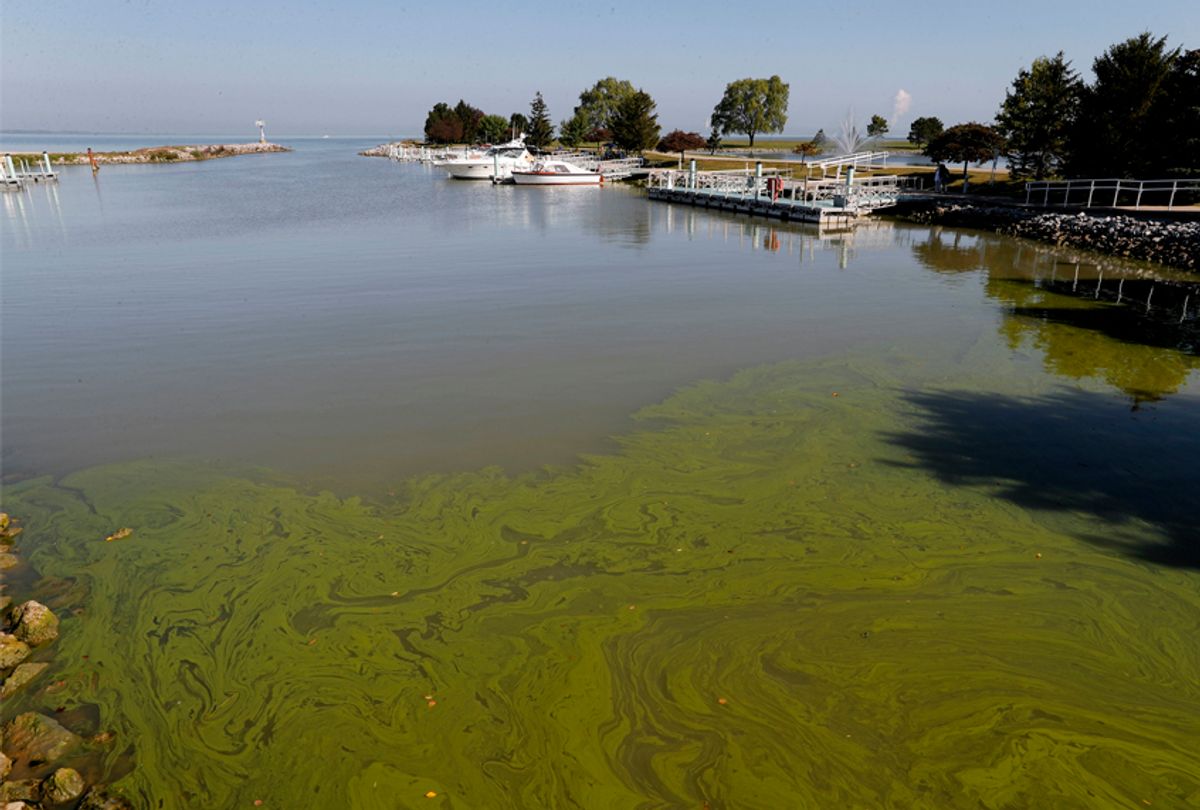The water crisis in Flint, Michigan, became a national news story, and for good reason. Republican leaders in the state were finally forced to take steps to stop the poisoning of Flint's drinking water with lead and other toxins, foisted on the community as part of a short-sighted cost-cutting measure. Despite improvements, the future of Flint's water supply is uncertain, but at least that story has brought increased attention to the problem of lead in water in many large cities, including Chicago.
The grim reality, however, is that the problems with American drinking water are diverse and widespread, even if most aren't quite as severe as what happened in Flint. Agricultural waste in particular is poisoning water, especially in rural areas, creating a myriad of health risks. Current government policy remains poorly equipped to deal with this issue.
This week, the Environmental Working Group (EWG) highlighted what it says is a growing problem of toxic algal blooms affecting the nation's water supply. These blooms are a soupy, green growth on waterways composed of cyanobacteria, which look like algae but are actually a different microorganism. That distinction is important because, as the EPA notes, cyanobacteria create toxins that are carcinogenic and linked to damage in the liver, kidneys and reproductive systems. They can also kill fish and pets. (Regular algae can cause problems but is not nearly as dangerous.)
In 2014, residents of Toledo, Ohio, lost their drinking water for days when the blooms in Lake Erie grew out of control. But no government agency regularly keeps track of this problem, so EWG tried to generate data by tracking news coverage and satellite imagery. Their researchers found 169 reports of toxic blooms in 2017. One reason these blooms are getting so bad is that levels of phosphorus, which works as a fertilizer for the blooms, are becoming extremely high in these waterways.
“Most of the phosphorus is coming from farms, because there’s phosphorus that’s applied as fertilizer," Craig Cox, EWG's senior vice president for agriculture and natural resources, told Salon. “The big issue . . . is that there are very few standards or regulatory measures, often none, to reduce the runoff from farm fields.”
Cox contrasted this with the regulations on industry, which tend to be far stricter than what's expected of farmers when it comes to what kinds of fertilizers and pesticides they may use on crops.
Phosphorus isn't the only fertilizer runoff that is linked with health problems. Nitrates, which are also linked to a series of major health problems, are also found in fertilizer and often end up in water supplies. Right now, the EPA requires public utilities to monitor drinking water to make sure that nitrate levels don't go above 10 milligrams per liter, because going above that is linked with the sometimes fatal "blue baby" syndrome. But the National Cancer Institute has linked higher cancer risks to much lower nitrate levels than that.
EWG reporting found, however, that there are 90 utilities in the U.S. that have nitrate levels far above the national limits. These tend to be in smaller communities and rural areas, but many of them have congressional representatives who sit on the House or Senate agricultural committees and still aren't getting their water cleaned up.
“The way the system works -- and this is especially true of contaminants associated with agriculture -- is that we’re relying almost entirely on treatment," Cox said. "We’re putting the burden of cleaning up water so it’s safe to drink almost entirely on the shoulders of utilities, instead of trying to prevent these contaminants from getting in the water in the first place.”
The problem, Cox said, is that the government's strategy for dealing with farm runoff is to hand out money, rather than subjecting farmers to regulation. The USDA spends billions on conservation programs that allow farmers to apply for grants to improve their runoff practices. All too often, he said, the money is spent on infrastructure improvements that benefit the farmers economically without doing nearly enough to reduce runoff.
“A lot of the money is spent on the least effective practices," Cox said. “What we’ve learned is that we can’t just wait for farmers to volunteer."
Americans still tend to think of farming as categorically different than industry, romanticizing agriculture as a family-oriented, salt-of-the-earth business. But in the 21st century, farming has long since become big business.
"Industrial agriculture is currently the dominant food production system in the United States. It's characterized by large-scale monoculture, heavy use of chemical fertilizers and pesticides, and meat production in CAFOs (confined animal feeding operations)," explains the Union of Concerned Scientists. "In fact, our industrialized food and agriculture system comes with steep costs, many of which are picked up by taxpayers, rural communities, farmers themselves, other business sectors, and future generations."
The group estimates that $2 billion is spent every year on cleaning up water contaminated by agricultural operations.
Cox believes there's a real opportunity for the federal government to shift focus towards heavier regulations that shift the cost away from taxpayers and can prevent drinking water from becoming polluted in the first place. The Flint story showed that Americans genuinely do care about the intersection of environmentalism and public safety, and can be compelled to focus on the threats to public health from contaminants in drinking water. Clean drinking water is a right, not a privilege, and one that is being violated every day because of corporate greed and government indifference. It wouldn't take much to change national policy toward ensuring healthy water for everyone.



Shares